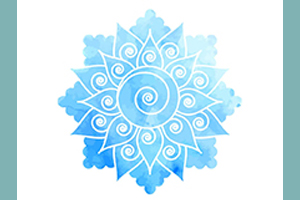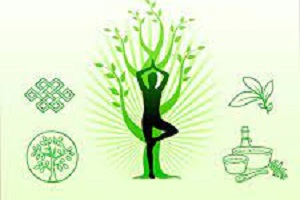By Setareh Kiumarsi
In Ayurveda, to describe the five fundamental elements in the body and mind, there are specific categories called “doshas”: Vata, Pitta, and Kapha.
Vata – Air and Space
The first dosha is Vata, which is dominated by the elements of space and air. It is cold, dry, light, penetrating, rough, and mobile. Mobility is the most important characteristic of this dosha. All vital functions in the body are accompanied by directional movements. For example, think about the downward movement in urination, defecation, and menstrual bleeding; or the back-and-forth movement of blood in the vessels, the inhalation and exhalation of air in the lungs, the heartbeat, the blinking of eyes, the movement of joints and muscles, and the mental activity in the mind.
The word Vata in Sanskrit means carrier, transporter, or medium. In the body, it functions like a vehicle that is responsible for all motor functions.
In some people, Vata dosha is genetically dominant and is the prevailing dosha in their Prakriti (genetic constitution). In others, Vata becomes imbalanced due to an incorrect lifestyle and poor eating habits. In general, in Ayurveda, when we speak about a dosha going out of balance, it means that the dosha (and thus the dominant elements and qualities in it) have increased in the body and mind. An increase in Vata in a person means the elements of space and air (and therefore the qualities of cold and dryness) have become dominant in their body and mind. Compared to the other two doshas (Pitta and Kapha), Vata is more prone to going out of balance.
Physical Characteristics of Vata-Type People
- Vata-type people are light and thin. Because of the dominance of space and air, their bodies have little mass and they gain weight with difficulty.
- Their height is either very tall or very short.
- Their skin is cold, dry, rough, and cracked.
- Their face is thin with sunken cheeks, dry skin, and visible fine and deep wrinkles.
- Their hair is dry and frizzy with a tendency toward split ends.
- Their eyes are small, the whites appear dull, they blink rapidly, and their eyes are often dry.
- Their nose is bony, often deviated, and has dry mucous membranes.
- Their tongue is thin, small, dry, and trembles, full of shallow and deep cracks.
- Their nails are dry, brittle, rough, dull, and marked with vertical lines.
- Their hands and feet are often cold, and cold easily penetrates their body.
- They dislike cold and dry climates and enjoy warm and humid environments.
- Excess air and space elements make their digestive tract too cold and weak. Their appetite fluctuates; they feel hungry quickly but also feel full quickly. Most of the time, due to extreme lightness in their body, they feel hungry mentally rather than physically, and often snack or eat junk food.
Mental Characteristics of Vata-Type People
- Vata-type people are always in motion; they dislike staying in one place. They love traveling and seeing new places.
- They are full of excitement and crave variety. They dislike repetitive tasks and like to multitask.
- They are highly creative; their mind leaps quickly and they are very imaginative. They often have talent in writing and artistic creation.
- They are talkative; they speak quickly, with interruptions, and a shaky tone. Their voice is high-pitched and they frequently jump from topic to topic.
- They memorize things quickly but forget just as fast.
Common Imbalances in Vata-Type People
- Gas and burping; excessive air in the digestive tract
- Abdominal pain and spasms
- Constipation and dry stool
- Cold hands and feet
- Trembling in body parts
- Dryness of skin, eyes, hair, and joints
- Extreme thinness
- Insomnia, poor or light sleep
- Anxiety, restlessness, overthinking, nervousness
- Negative thoughts, fear, emptiness, loneliness, lack of focus, impatience
Key Solutions to Restore Vata Balance
The dominant qualities in Vata dosha are cold and dry. If Vata is genetically dominant in a person’s Prakriti or has become excessive due to improper lifestyle or diet, then cold and dry qualities must be reduced in their routine, and they should expose themselves to warmth and moisture.
Diet and Restrictions
If Vata is your dominant dosha or you’re experiencing Vata imbalance, reduce the intake of cold and dry foods and learn how to consume them properly. What foods are cold and dry?
- Most legumes. Avoid overconsumption. Refrain from eating legume-based dishes (like lentil soup, legume-heavy soups, falafel, hummus, etc.) more than once every 7–10 days. In general, small legumes (like mung beans and red lentils) are easier to digest than large ones. Always soak legumes overnight, change the water multiple times, and cook them with proper oils and balancing spices. In a meal, legumes should not exceed 10–20% of your plate (e.g., think of lentil rice with very little lentil). Drink a glass of digestive lassi with these meals.
- Cold and dry vegetables (like lettuce, cabbage, cauliflower, broccoli, Brussels sprouts, endive, kale, celery, and cilantro). Eating these raw in salads severely aggravates Vata. Cook them with suitable oils (like ghee, sunflower oil, coconut oil, olive oil, or canola oil) and balancing spices. Use three units of warming spices (fennel, turmeric, cardamom, cinnamon, cumin, basil, thyme, rosemary, black cumin, saffron, etc.) for every one unit of cooling spice (coriander seed, rose, sumac, dried lime, mint).
- Instead of typical salads, which are full of raw, cold, dry vegetables, eat digestive salads.
Further Vata Dietary Cautions
- Potatoes are very cold and dry. Minimize dishes and snacks based on potatoes (like potato rice, chips with cheese, mashed potatoes, potato patties, baked potatoes, etc.). If you eat them, pair them with proper oils (olive, coconut, sunflower, or canola) and warming spices (fennel, thyme, cumin, black cumin, or turmeric).
- Do not eat apples, quinces, or pears raw. Eating these raw increases dryness in the digestive tract (and worsens Vata imbalance). Cook them with warming spices (like cardamom, cinnamon, saffron, or vanilla) and a bit of syrup.
- Avoid bitter (like malt drinks), astringent (like quince), and pungent (like red chili) flavors.
- Eliminate caffeine (coffee, instant coffee, black tea, green tea, cocoa) as it causes severe dryness in the digestive tract and significantly aggravates Vata. Experience life without caffeine to help bring Vata back into balance.
Recommended Diet
- Include at least one soupy meal in your daily diet. Your digestive tract needs warmth and moisture to regain balance. From two hours after any meal, drink a glass of digestive tea every hour. Also, drink a glass of digestive lassi with lunch and dinner. Digestive lassi is one of the best and most effective ways to balance Vata.
- Use balancing spices like fennel, green cumin, cinnamon, cardamom, saffron, nutmeg, rosemary, and thyme generously. They warm your body and ignite your digestive fire.
- Incorporate sweet (like dates), sour (like oranges), and salty (like pickles) flavors in your diet.
Lifestyle
- The most essential way to keep Vata balanced is routine. Bring order to your life. Set a specific schedule for meals, work, exercise, sleep, and wake time; and stick to it.
- Remember that insomnia, late nights, and irregular sleep patterns are major causes of Vata imbalance. So regulate your sleep and go to bed no later than 10 PM.
- Avoid exposure to cold and wind. Your body and mind love warmth and humidity. Incorporate massage with suitable oil (sesame or sweet almond oil), warm showers, and steam inhalation into your daily routine. Before bed, massage the soles of your feet with oil suited to your constitution.
- Avoid intense exercise (especially those involving high-impact movements like jumping, horseback riding, running, long-distance cycling, or high-altitude hiking). Gentle, light exercises like walking, yoga, Tai Chi, Qigong, and short hikes are better for you.
- Avoid excessive travel. Travel involves constant movement and naturally aggravates Vata. Stillness, grounding, routine, and settling in one place restore balance to Vata. Avoid back-to-back unnecessary trips and allow time between them.
- Go easy on yourself. Don’t multitask. In all aspects of life, instead of rushing, move slowly and steadily. Take breaks and breathe.
- And most importantly, don’t forget to meditate.
Please be sure to credit the author, Setareh Kiumarsi, when sharing or republishing this article, which was written with love and the hope of well-being for all.






